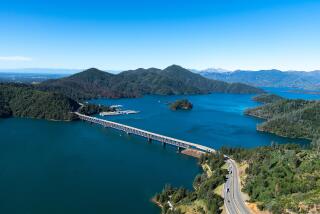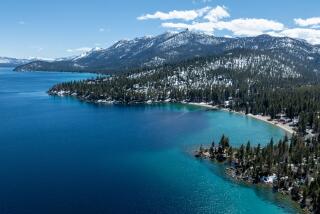Water in Lake Tahoe Gets Clearer
- Share via
Researchers announced on Wednesday that Lake Tahoe has achieved its best clarity in five years, but cautioned that the battle has not yet been won to reverse decades of decline in the alpine lake’s sapphire-blue waters.
Scientists at UC Davis’ Tahoe Research Group said a person could see 73 feet into the lake’s depths this year, a big jump from last year when a white plate suspended from a line could on average be seen at a depth of 67 feet.
Charles Goldman, director of the research lab that has studied the lake’s waters for the last four decades, said clarity would have to improve for at least another five years before scientists would feel comfortable declaring a significant victory.
“The long-term trend of clarity loss is still significant,” Goldman said. “We’ve still got a lot more to do to reduce the impacts of the average citizen on the lake.”
For generations, Lake Tahoe’s famously clear waters have grown dingier because of runoff in the fast-growing basin. Sediment clouds the water, while chemicals, fertilizers and other pollutants promote algae growth. In 1968, when UC Davis clarity studies began, the disk could be seen at a depth of 102 feet.
More than $900 million in state, federal and private funds has been committed to curb erosion, restore wetlands and buy land to ease the impact on the water.
Although basin-restoration activities probably contributed to the improvement last year, Goldman and other researchers also believe that reduced runoff played a part in 2001, which was a drought year. The worst recent year for lake clarity was 1997, a year of record rain and floods.
Goldman and his team have warned for years that if the clarity decline is not checked, the lake’s deep blue water will turn green.






